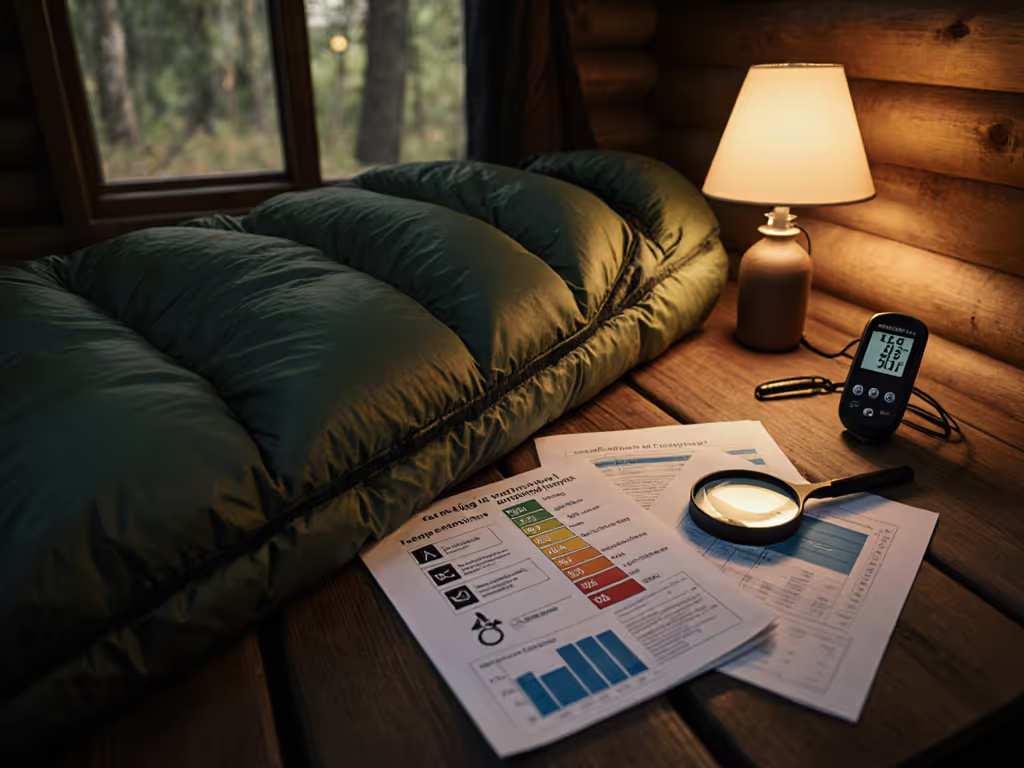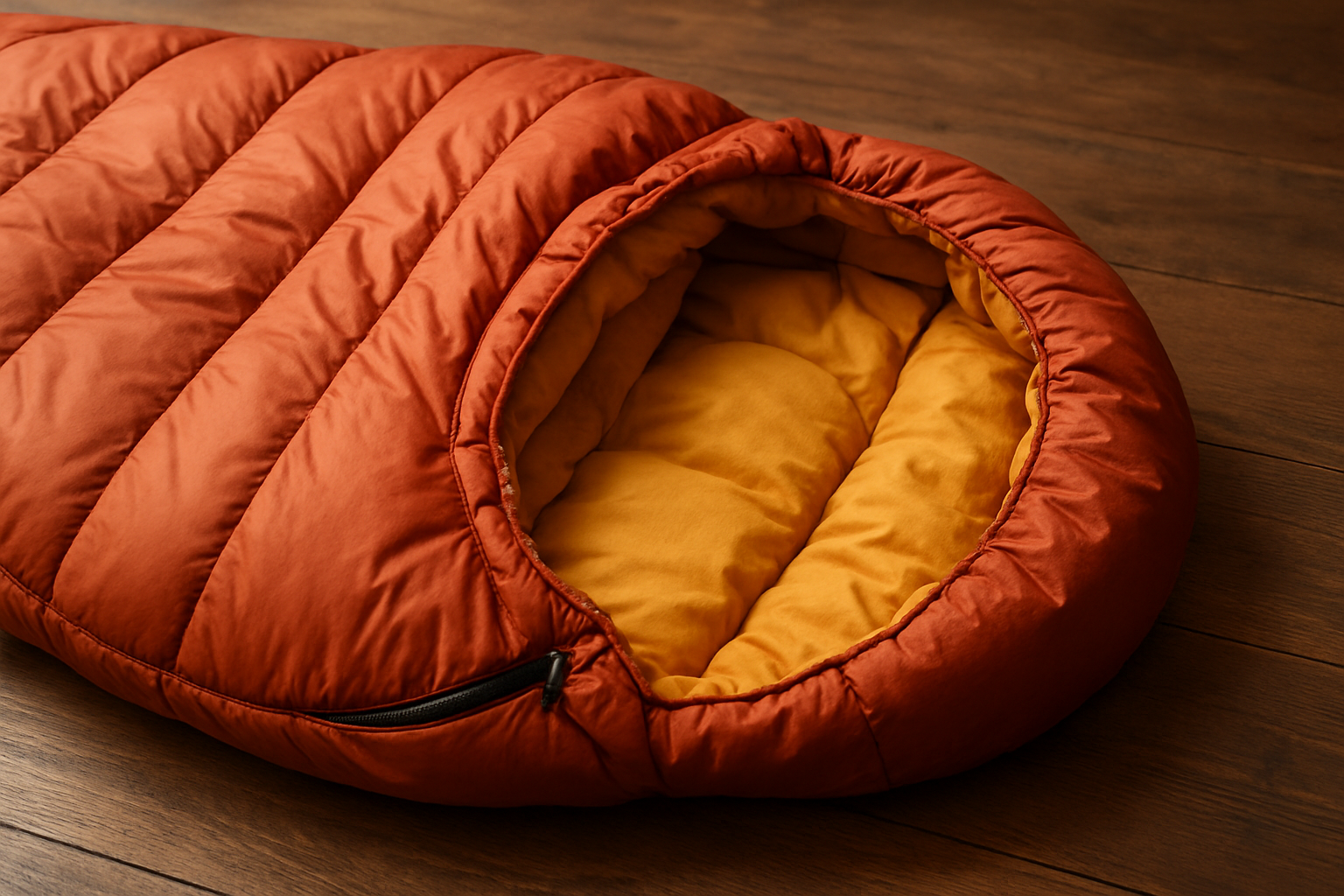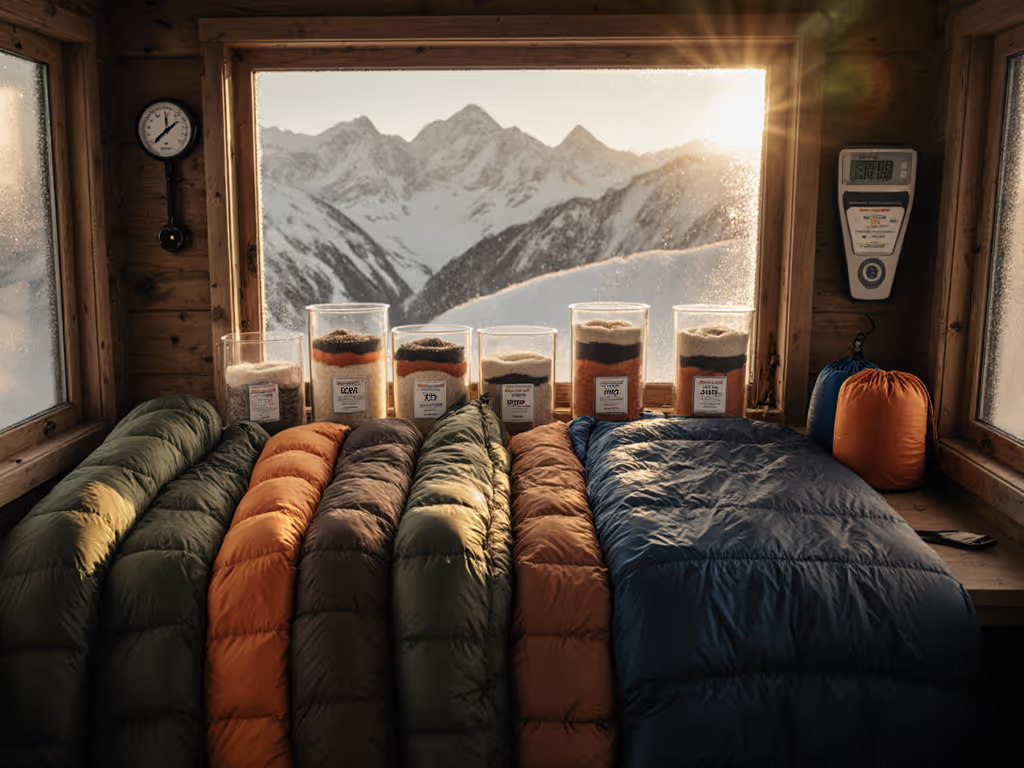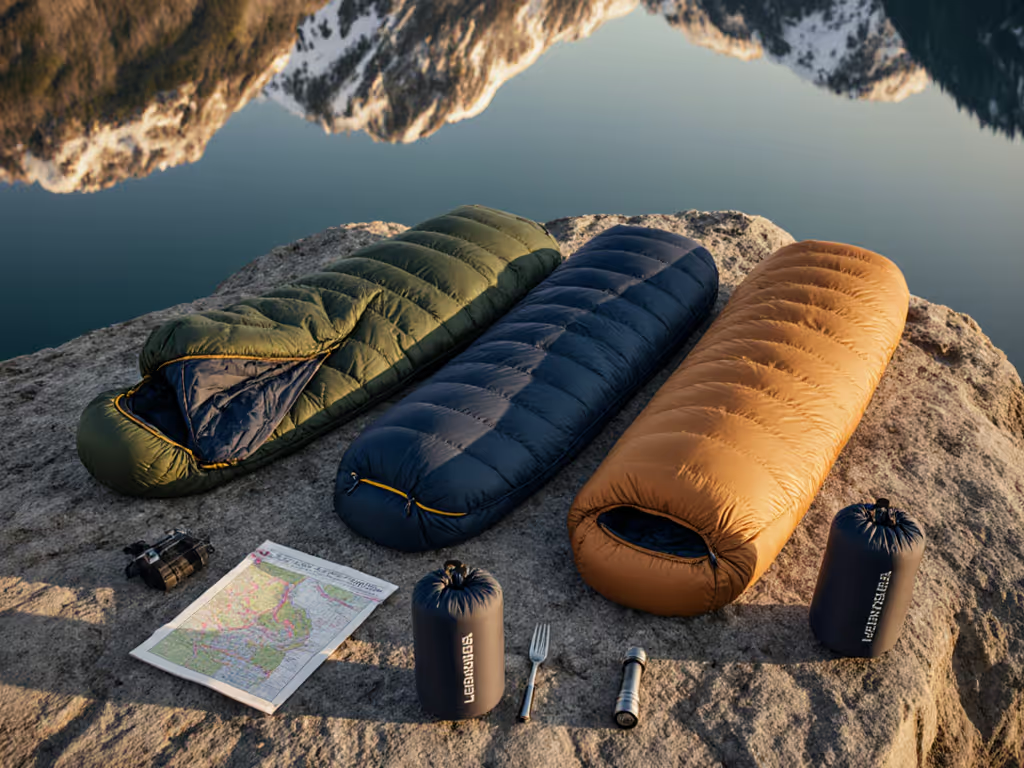
What Do ISO Ratings Mean for Sleeping Bags? A Backpacker's Guide to Real Warmth and Comfort

If you have ever stared at a hangtag wondering what do iso ratings mean for sleeping bags, you are not alone. Those lab-tested numbers are helpful, but they do not always translate cleanly to a windy ridge or a damp valley camp. As you weigh warmth against weight, cost, and comfort, the goal is simple: sleep through the night and wake up strong. At Backpacker Sleep, we translate International Organization for Standardization (ISO) lab ratings into plain language, then explain how real-world variables like pad R-value (thermal resistance measure), humidity, and fit affect warmth so you can make informed choices about a sleeping bag that actually feels warm where and when you camp.
In this guide, you will learn how International Organization for Standardization (ISO) 23537 testing works, what the Comfort, Limit, and Extreme ratings really mean for your body, and how to adjust for factors the lab cannot simulate perfectly. Along the way, we will compare down and synthetic insulation, unpack eco-minded choices, and offer practical, field-tested guidance to help you choose your next bag. Ready to turn numbers into nights of solid sleep?
what do iso ratings mean for sleeping bags
International Organization for Standardization (ISO) 23537 is the global testing standard most reputable brands use to rate adult sleeping bags. It produces three headline temperatures designed to help you predict comfort. The numbers are not a promise, but a shared language so you can compare apples to apples across brands. Think of them as a weather forecast for your sleep system: close to reality, but always improved by local knowledge and good judgment.
Here is the terminology you will see on tags and spec sheets, decoded for actual trail use. Notice how each rating assumes a specific sleeper, position, and setup. If you tend to run cold, you will anchor on Comfort. If you sleep hot, you may look at Limit. Extreme is a survival-only data point, not a target for normal trips.
| ISO 23537 Term | Plain-English Meaning | Who It Fits | Trail Takeaway |
|---|---|---|---|
| Comfort | Temperature at which a standard cold-prone sleeper can sleep comfortably in a relaxed position. | Many women and cold sleepers; side or back sleepers who do not want to feel chilly at bedtime. | If you dislike the cold, choose a bag with Comfort at or slightly below your expected low. |
| Limit | Temperature at which a standard warm-prone sleeper can sleep without waking due to cold in a curled position. | Many men and warm sleepers who are fine being on the edge of chilly. | Use if you run hot, sleep in layers, and have a high R-value (thermal resistance measure) pad. |
| Extreme | Minimum temperature for survival for a standard sleeper; risk of hypothermia and frostbite rises. | Nobody for comfort; emergency reference only. | Do not shop by Extreme. It is not a comfort rating. |
International Organization for Standardization (ISO) ratings were preceded by European Norm (EN) 13537 (European Norm), which used similar concepts. For a practical walkthrough on matching ratings to real conditions, see our EN/ISO comfort matching guide. If you see older EN numbers, you can generally treat Comfort and Limit the same way, but confirm the test era if you are comparing legacy models. Regardless of the label, the key is choosing a rating that reflects your metabolism, pad R-value (thermal resistance measure), shelter, and humidity on the trips you actually take.
Inside the Lab: How ISO 23537 Testing Works
International Organization for Standardization (ISO) 23537 testing places a heated, sensor-equipped mannequin inside a sleeping bag on a standardized sleeping pad with a defined R-value (thermal resistance measure) in a controlled climate chamber. The mannequin is dressed in base layers and a hat to simulate typical sleepwear. Technicians then measure heat loss and compute the Comfort, Limit, and Extreme temperatures using established formulas. Because the environment is consistent, you can compare ratings across different brands and models.
Watch This Helpful Video
To help you better understand what do iso ratings mean for sleeping bags, we've included this informative video from REI. It provides valuable insights and visual demonstrations that complement the written content.
Of course, a lab chamber cannot simulate everything you will encounter on trail. Wind robbing warmth under a tarp, condensation saturating the shell, or a half-deflated pad at 3 a.m. can swing reality by several degrees Celsius. Industry lab notes and field reports consistently show that the sleeping pad’s R-value (thermal resistance measure), bag fit, and humidity are among the biggest variables. That is why Backpacker Sleep pairs the lab number with practical field-adjustment guidance readers can apply based on their body, pad, and camp setup.
- Assumed Clothing: Lightweight base layers and a beanie, not a puffy. If you sleep in more, you can push lower; less, and you will feel colder.
- Pad Standardization: A defined R-value (thermal resistance measure) pad is used. If your pad is thinner or has a lower R-value (thermal resistance measure), expect to lose warmth to ground conduction.
- Position: Comfort assumes a relaxed posture; Limit assumes curled. Your posture and fidget factor matter more than you think.
- Moisture: The chamber does not mimic tent condensation, wet socks, or a damp bag. Moisture is a major heat thief.
From Numbers to Nights: Translating Ratings to Real-World Warmth
So, how do you pick a rating for your trip? Start with your expected overnight low for the coldest night, then decide whether you want to anchor on Comfort or Limit. Next, adjust for your pad R-value (thermal resistance measure), shelter exposure, humidity, and personal metabolism. As a rule of thumb, cold-prone sleepers should choose a Comfort rating at or below the forecasted low, while warm sleepers can use the Limit rating with a buffer of 2 to 5 Celsius degrees.
Consider a quick field example. Maya, a self-described cold sleeper, plans shoulder-season hikes with lows around 0 Celsius degrees. She uses a high R-value (thermal resistance measure) pad and a double-wall tent. She chose a bag with a Comfort of -5 Celsius degrees and reported cozy sleep even on frosty mornings. Meanwhile, Nate, a warm sleeper who often hikes under a tarp, found that a Limit-rated bag equal to the forecast low felt marginal until he upgraded his pad and added a draft-resistant liner.
| Overnight Low | Pad R-value (thermal resistance measure) | Sleeper Type | Suggested Bag Target | Notes |
|---|---|---|---|---|
| +10 Celsius degrees to +5 Celsius degrees | 2 to 3 | Warm | Limit near forecast | Vent easily; choose breathable shell to manage humidity. |
| +5 Celsius degrees to 0 Celsius degrees | 3 to 4 | Cold | Comfort 2 to 5 Celsius degrees below forecast | Add hat and dry socks; consider a draft collar and hood. |
| 0 Celsius degrees to -5 Celsius degrees | 4 to 5+ | Average | Comfort at forecast or lower | Wind exposure and moisture can swing warmth by multiple degrees. |
| -5 Celsius degrees to -12 Celsius degrees | 5+ | Cold | Comfort 5 to 8 Celsius degrees below forecast | Prioritize draft collar, snug fit, and high-loft insulation. |
Because local conditions vary, Backpacker Sleep tests kits as a system and shares how Comfort, Limit, and pad R-value (thermal resistance measure) interact under wind, humidity, and shelter differences. When you combine the International Organization for Standardization (ISO) number with smart field adjustments, your odds of sleeping warmly go way up.
Fit, Pad R-value (thermal resistance measure), and Humidity: The Comfort System

Warmth is a team sport. Even the best-rated bag will underperform if the fit is sloppy, the pad is under-insulated, or the microclimate is damp. A close, non-restrictive mummy shape reduces dead air you must heat. A hood and draft collar lock in warmth around your head and neck, which can otherwise dump a surprising amount of heat. Meanwhile, your sleeping pad is the unsung hero guarding against ground conduction. To eliminate cold spots from poor fit, use our sleeping bag size guide.
Humidity complicates everything. Damp air increases conductive and evaporative heat loss, and condensation can flatten loft. Shells with durable water repellent finishes, ideally perfluorinated compound (PFC)-free Durable Water Repellent (DWR), help shed moisture, but you still want to manage ventilation. Simple habits like drying your base layers, cracking a vent, and keeping the footbox off wet tent walls often add more warmth than another 100 grams of insulation.
- Pick the Right Size: Too big wastes heat; too small compresses insulation. Try to match shoulder, hip, and foot girths to your body.
- Mind the Pad: Increase pad R-value (thermal resistance measure) as temperatures fall. Many hikers add a thin closed-cell foam under an air pad in shoulder seasons.
- Control Moisture: Sleep in dry base layers, air out your bag at first light, and vent the shelter to reduce condensation.
- Layer Intelligently: Light base layers and a beanie align with the test assumptions; add a puffy if conditions dip below your rating buffer.
Down vs Synthetic: Insulation, Sustainability, and Climate
Both down and synthetic insulation can meet International Organization for Standardization (ISO) ratings, but they behave differently outside the lab. Down offers exceptional warmth-to-weight and compressibility, especially at higher fill powers, while synthetic fibers keep more warmth when damp and dry faster. Your climate, trip length, and care habits should guide the choice. Sustainability considerations, from Responsible Down Standard (RDS) (Responsible Down Standard) certifications to Global Recycled Standard (GRS) (Global Recycled Standard) fabrics and perfluorinated compound (PFC)-free Durable Water Repellent (DWR) coatings, also matter to many backpackers.
| Factor | Down Insulation | Synthetic Insulation |
|---|---|---|
| Warmth-to-Weight | Best-in-class when dry; very packable at high fill power. | Heavier for the same warmth; bulkier in the pack. |
| Moisture Performance | Loft can collapse when wet; hydrophobic treatments help. | Retains more loft and warmth when damp; dries faster. |
| Durability | Long lifespan if well cared for; avoid prolonged compression. | Resilient to rough use; fibers slowly fatigue over time. |
| Price | Often higher upfront, especially premium fill. | Usually more affordable at entry to mid tiers. |
| Eco Pathways | Look for Responsible Down Standard (RDS) (Responsible Down Standard); perfluorinated compound (PFC)-free Durable Water Repellent (DWR) shells where possible. | Seek recycled fibers certified to Global Recycled Standard (GRS) (Global Recycled Standard); perfluorinated compound (PFC)-free Durable Water Repellent (DWR). |
| Best For | Cold, dry climates; long trips where weight and packability matter. | Wet, humid regions; fast-and-light trips with unpredictable weather. |
Backpacker Sleep’s comprehensive reviews compare similar International Organization for Standardization (ISO)-rated bags with different insulations in the same conditions. For deeper pros and cons by climate and use case, read our down vs synthetic comparison. That way, you can see how a -7 Celsius degree down mummy bag performs next to a -7 Celsius degree synthetic in fog, wind, and frost. The numbers converge in the lab, but real warmth depends on how the materials behave where you camp.
The Backpacker Sleep Method: Choose with Confidence
At Backpacker Sleep, we specialize in simplifying the lab so you can sleep warmly in the wild. We pair International Organization for Standardization (ISO) ratings with practical field adjustments, then test full sleep systems. Our detailed guides cover fit and sizing, pad R-value (thermal resistance measure) matching, humidity management, and sustainable materials, so you understand both the numbers and the nuances. The result is a kit that feels dialed, not experimental.
Use this step-by-step approach for reliable picks, then explore our comprehensive reviews on sleeping bags for various conditions to see real examples and data. When the forecast or your itinerary changes, you will know exactly how to adapt without overpacking or shivering.
- Set Your Target Low: Find the coldest realistic overnight temperature for your trip window.
- Pick Your Anchor: Cold sleepers use Comfort; warm sleepers consider Limit, with a 2 to 5 Celsius degree safety buffer.
- Match Your Pad: Choose a pad R-value (thermal resistance measure) that fits the temperature and your shelter exposure.
- Dial the Fit: Aim for a bag that hugs without squeezing; confirm shoulder and hip girth and footbox volume.
- Plan for Moisture: Favor breathable shells and perfluorinated compound (PFC)-free Durable Water Repellent (DWR); manage condensation with smart venting.
- Check the Details: Draft collar, hood shape, zipper anti-snag, and fabric hand-feel all influence perceived warmth and comfort.
Buyer’s Cheat Sheet: Features That Add Real Warmth

Not all features are created equal. Some add measurable warmth; others are convenience or durability upgrades. When two International Organization for Standardization (ISO)-rated bags look the same on paper, these details usually decide which one feels warmer and easier to live with at 2 a.m.
| Feature | Why It Matters | Warmth Impact | Backpacker Sleep Tip |
|---|---|---|---|
| Draft Collar and Hood | Seals heat at the neck and head, key heat-loss zones. | High in windy or sub-freezing camps. | Look for an easy-to-use, low-snag cinch you can adjust in the dark. |
| Face Fabrics and Liner | Breathability controls moisture; soft liners improve perceived warmth. | Moderate in humid regions. | Perfluorinated compound (PFC)-free Durable Water Repellent (DWR) is kinder to ecosystems. |
| Zipper Baffle and Anti-Snag Guard | Prevents cold leaks and fabric damage. | Moderate, especially in windy sites. | Full-length baffles are warmer; half zips save weight but reduce venting. |
| Footbox Design | Room for natural toe splay without compressing insulation. | Moderate; cold feet ruin nights. | Boxed construction beats flat seams for loft retention. |
| Fill Power and Distribution | Higher down fill power packs smaller for same warmth; mapped insulation keeps warmth where needed. | High when fit is dialed. | Check for over-stuffed baffles in high-loss areas like the torso. |
When you are choosing between two similar International Organization for Standardization (ISO) ratings, run through this checklist and weight the features for your climate. If fill power specs confuse you, see our fill power explainer for plain-English tradeoffs. Backpacker Sleep’s comparison reviews highlight these real-world differences, so you can pick confidently without having to decipher marketing copy.
Real-World Factors: Quick Adjustments That Matter
Even with the right International Organization for Standardization (ISO) rating and fit, a few field practices can swing your comfort by multiple degrees. The goal is to conserve the warmth you have already generated and reduce heat loss through conduction, convection, and evaporation. Small habits add up fast and are easier than carrying a heavier bag. For step-by-step tactics, check our stay-warm checklist.
- Fuel the Furnace: Eat a warm, balanced meal and hydrate before bed; a well-fed body is a stronger heat source.
- Dry Before You Crawl In: Damp base layers steal heat; change into dry socks and a light beanie.
- Venting Smart: Use the zipper and draft collar to tune microclimate and minimize condensation.
- Shield from Wind: Pitch behind natural windbreaks; even a low breeze can undercut warmth dramatically.
- Protect the Pad: Keep valves tight and the surface clean to maintain pad R-value (thermal resistance measure) through the night.
Backpacker Sleep weaves these field tactics into every review, especially in our comprehensive reviews on sleeping bags for various conditions. Because when numbers meet practice, you do not just survive the night - you enjoy it.
These International Organization for Standardization (ISO) ratings are your compass; your body, gear, and environment are the terrain. Use them together and you will spend your nights dreaming, not calculating. And when in doubt, add a little buffer. Warm sleep is worth a few extra grams.
Backpacker Sleep: Your Partner for Data, Context, and Comfort
Many backpackers struggle to balance warmth, weight, and comfort when faced with technical lab ratings. Backpacker Sleep was built to solve exactly that. We offer detailed guides that demystify International Organization for Standardization (ISO) and lab metrics, then ground them in real-world warmth with fit advice, pad R-value (thermal resistance measure) pairing, and humidity management. Our focus on eco-friendly picks surfaces Responsible Down Standard (RDS) (Responsible Down Standard) down, Global Recycled Standard (GRS) (Global Recycled Standard) synthetics, and perfluorinated compound (PFC)-free Durable Water Repellent (DWR) shells that respect the places you camp.
Explore our comprehensive reviews on sleeping bags for various conditions to see how similar International Organization for Standardization (ISO)-rated bags perform on snow, in fog, and under clear skies. Compare down versus synthetic options for your climate, learn how to tune your sleep system, and use our reviews and buying guides to pick a bag that fits your body and your goals. The site provides practical explanations of International Organization for Standardization (ISO) and lab ratings, along with real-world guidance on fit, insulation, and eco-friendly considerations to help users make informed, comfortable choices.
Armed with this knowledge, you will no longer ask what do iso ratings mean for sleeping bags in the abstract. You will know what they mean for you, in your tent, on your next trip.
Trail-Ready Examples: Scenario Planner
Want a quick cross-check before you buy? Use these sample scenarios as a sanity check alongside the International Organization for Standardization (ISO) tag. They are not rules, but they reflect thousands of field nights and the patterns we repeatedly see in testing. Adjust up or down as you learn how your metabolism, pad R-value (thermal resistance measure), and shelter interact.
| Scenario | Conditions | System Highlights | Likely Best Pick |
|---|---|---|---|
| Coastal Spring | +7 Celsius degrees lows, fog, high humidity | Synthetic bag or treated down; breathable shell; R-value (thermal resistance measure) 3 to 4 pad | Comfort near +2 to 0 Celsius degrees |
| High Desert Shoulder Season | 0 Celsius degrees lows, dry air, breeze | Down bag with draft collar; wind-protected pitch; R-value (thermal resistance measure) 4 to 5 pad | Comfort -5 Celsius degrees |
| Alpine Summer | +3 Celsius degrees lows, potential wind | Light down or synthetic; solid hood; R-value (thermal resistance measure) 3.5 to 4 pad | Comfort -2 to -4 Celsius degrees |
| Humid Forest Storm | +10 Celsius degrees lows, heavy rain | Fast-drying synthetics; aggressive venting; R-value (thermal resistance measure) 2.5 to 3 pad | Limit at forecast, but prioritize moisture control |
If your plans span multiple climates, Backpacker Sleep provides guidance to map a two-bag quiver and a pad strategy that covers your seasons without overbuying. That is how you turn International Organization for Standardization (ISO) numbers into dependable sleep across the calendar.
--
Warmth you can trust comes from understanding the numbers and mastering the variables that matter most. Imagine heading into your next trip knowing your bag, pad, and pitch work together like a tailored system. In the next 12 months, a smarter kit could mean lighter packs, deeper sleep, and longer miles.
So the next time someone asks, what do iso ratings mean for sleeping bags, will you point to a tag - or to your own cozy, real-world experience?
Additional Resources
Explore these authoritative resources to dive deeper into what do iso ratings mean for sleeping bags.
- Understanding Sleeping Bag Temperature Ratings - REI
- Sleeping Bag Temperature Ratings: EN/ISO Ratings | Therm-a-Rest
Decode International Organization for Standardization (ISO) Ratings with Backpacker Sleep
Backpackers, hikers, and campers get comprehensive reviews on sleeping bags for various conditions plus clear International Organization for Standardization (ISO) guidance to make confident, comfortable, eco-minded choices.



